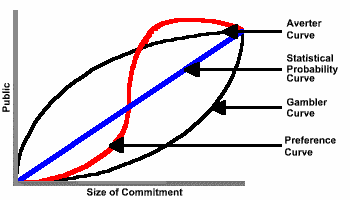WEEK 13: DIRECTING: DECISION MAKING
Sections: Decision Making | Risk | Importance of Decision | Students' Corner
Decision Making
Definition.
A process of consciously choosing a course of action from available alternatives for the purpose of achieving a result.
Steps.
1. Background Analysis
Understand the situation, by analyzing past actions and predetermined objectives.
2. Problem Identification
Recognize the limiting factors. Use means-end chain.
3. Search/Analysis of Avilable Alternative
Use logic. Premise is the statement of the relationship between the cause and the consequence. Say: "If we do A, the B will result".
4. Selection of the Solution
5. Implementation / Monitoring
Environment of Decision Making.
1. Decision-making under conditions of certainty.
Complete certainty of the future. Used for very routine decisions.
2. Decision-making under conditions of uncertainty.
No prior knowledge to permit assignment of probabilities. More than one state of nature exists. Probability is the chance that something will happen, or, mathematically the number of favorable outcomes with respect to the total number of possible outcomes.
 Criteria:
Criteria:
a) Maximax Criterion - optimism, maximum pay-off. Choose best of bests.
b) Maximim Criterion - maximize hits with minimum possible pay-off. Choose best of worst.
c) Minimax Regret Criterion - minimize maximum regret.
d) Criterion of realism - between maximax and maximin which requires a specification of the index of optimism, a. Thus, measure of realism = a(maximum pay-off) + (1-a)(minimum pay-off).
3. Decision-making under conditions of risk.
More than one state of nature exists and has information that probability values can be assigned.
 Criteria:
Criteria:
a) Expected Value Criterion (Bayes) - calculation of expected value for each alternate multipled by its potential value.
b) Criterion of Rationality - (Bernoulli or insufficient reason) - in the absence of strong information to the contrary, assume all the stated of nature are equally likely..
c) Maximum Likelihood Criterion - selects the state of nature which has the highest probability of occurence and picks the decision alternate which yields the highest pay-off for that state.
Methods of Analysis.
A. Stochastic -systematic thinking of assumptions, facts and goals. Using the following
 1. Pay-off Table - a table of conditional values for each strategy under each state of nature and uncontrollable factors that determine success and failure.
1. Pay-off Table - a table of conditional values for each strategy under each state of nature and uncontrollable factors that determine success and failure.
2. Decision Tree - shows each choice situation together with each pay-off and each probability.
B. Simulation - A quantitative procedure which describes a process by developing a model of that process and then conducts a series of organized trial and error experiments to predict the behavior of the process over time. Used in Markov analysis and queue, or waiting lines.
 C. Break-Even Analysis - uses the relationship of revenue and cost. At some point of operation the total revenue, TR, is equal to the total costs, TC. Total cost is a fucntion of both the fixed, FC, and the variable, VC, costs. Thus, the break-even point, BEP, is equal to the total fixed cost, FC, divided by 1 - VC/S, where S is equal to (FC + VC)x % of sales.
C. Break-Even Analysis - uses the relationship of revenue and cost. At some point of operation the total revenue, TR, is equal to the total costs, TC. Total cost is a fucntion of both the fixed, FC, and the variable, VC, costs. Thus, the break-even point, BEP, is equal to the total fixed cost, FC, divided by 1 - VC/S, where S is equal to (FC + VC)x % of sales.
D. Incremental Concept - uses the analysis of changes in total revenues and the total costs.
Sections: Decision Making | Risk | Importance of Decision | Students' Corner
Risk
Theories.
Preference (Utility) Theory states that individual attitudes toward risk will vary -- some individuals are risk averters and others are risk gamblers.

Risk averters are individuals willing to take only lower risks
Risk gamblers are individuals willing to take greater risks.
The curve above implies that most of us are gambles when small stakes are involved but become risk averters when stakes rise.
Factors that affect the acceptance of risks are: the individual, the size of risk, the level of management and the source of funds (personal or company).
Sections: Decision Making | Risk | Importance of Decision | Students' Corner
Importance of Decision
1. Extent of Responsibility.
Decision is variable with respect to the size and length of commitment. Usually, upper management levels is required for subjects like: heavy expenditures, important personnel decisions, and plant expansion.
2. Flexibility of Plans.
Decisions with inflexinle actions are prioritized over decisions that can easily be changed.
3. Certainty of Goals and Premiums.
Decisions which are certain outcomes are less difficult to make.
4. Quantifiability of Variables.
When goals, inputs, restrictions, or variables can be accurately measured, important decisions is less difficult to make, like pricing a new product, or deciding on style.
5. Human Impact.
When decisions will affect a great number of persons, usually high level managers makes them. Lower level managers and non-managers could handle programmed decisions -- structured problems and routine decisions, while unprogrammed decisions are tackled by upper level managers.
Sections: Decision Making | Risk | Importance of Decision | Students' Corner
Students' Corner
Seatwork 01. Risk.
1. Do the following seatwork for thirty minutes.
2. Once finished, exchange your work with a classmate
3. Evaluate your classmate's answers and decide what type of risk-taker your classmate is.
Home |
EM |
Sites |
ABdA |
Help |
E-mail

